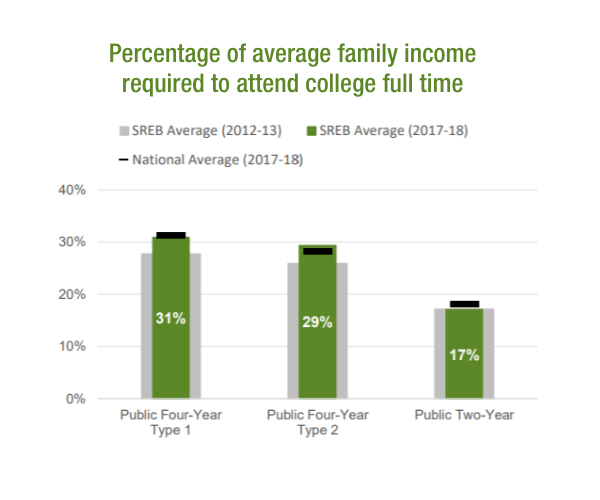Costs of four-year college rose sharply for low-income families even before pandemic
ATLANTA — The lowest-income families in many Southern states
saw major five-year increases in the share of their income
required to send a student to a public four-year university — and
the pandemic could make the situation worse.
The Southern Regional Education Board’s new college-affordability
profiles for the South and 16 individual states show the
average family had to spend 31% of annual income after financial
aid for all the educational expenses of a full-time student at
four-year research universities in 2017-18, the most recent
comparable data available.
But in some states, families earning under $30,000 — the region’s
largest segment of families with children in college — would have
to pay more than their entire annual
income for a student to attend one year at a four-year
research university. And that’s after financial aid is made
available.
“Making college affordable and possible for every student is a
critical part of improving our workforce — and this issue is even
more pressing as states deal with the economic impacts of the
pandemic,” SREB President Stephen L. Pruitt said.
And fewer families are applying for financial aid in most SREB
states. In 2020 compared with 2019, the rate of students
completing the federal FASFA form dropped by an average of 15%
overall and by an average of 22% in the region’s high schools
which largely serve students from low-income families.
“Two- and four-year colleges should be engines of recovery as
every state and community adjusts to a fourth industrial
revolution brought about by automation and technology-driven
changes in nearly every profession,” Pruitt said. “Financial aid
for students who most need the support is especially critical in
this era.”
For the region’s average-income families in 2017-18, 29% of their
income was required for the net price at regional four-year state
institutions and 17% on average to cover educational expenses at
two-year institutions in SREB states.
Tuition has continued to rise substantially across the region,
from an average of $6,216 per full-time equivalent student in
2007-08 to $9,914 in 2017-18 in public four-year colleges. State
appropriations per student for four-year colleges continued to
decline, from $7,857 to $6,827 per FTE student in the same
decade.
In the region’s public two-year colleges, average net tuition and
fees in the region rose from $2,296 per FTE student in 2007-08 to
$3,149 in 2017-18. But state appropriations for two-year colleges
also increased on average in the region, from $4,845 to $5,262
over the same period.
Data in these affordability profiles is from 2017-18, the most
recent comparable data available, and does not reflect the impact
of the pandemic. Now, as many states face budget shortfalls and
students and their families face financial hardship, many
students may find it even more difficult to afford college.
For more information, see SREB’s college
affordability brief on the entire region and
the 16 individual
state affordability profiles.
NEWS RELEASES FOR EACH STATE:
Read
the Alabama release>
Read the
Arkansas release>
Read the
Delaware release>
Read the
Florida release>
Read the
Georgia release>
Read the
Kentucky release>
Read the
Louisiana release>
Read the
Maryland release>
Read the
Mississippi release>
Read the
North Carolina release>
Read the
Oklahoma release>
Read the
South Carolina release>
Read the
Tennessee release>
Read the
Texas release>
Read the Virginia
release>
Read the
West Virginia release>

